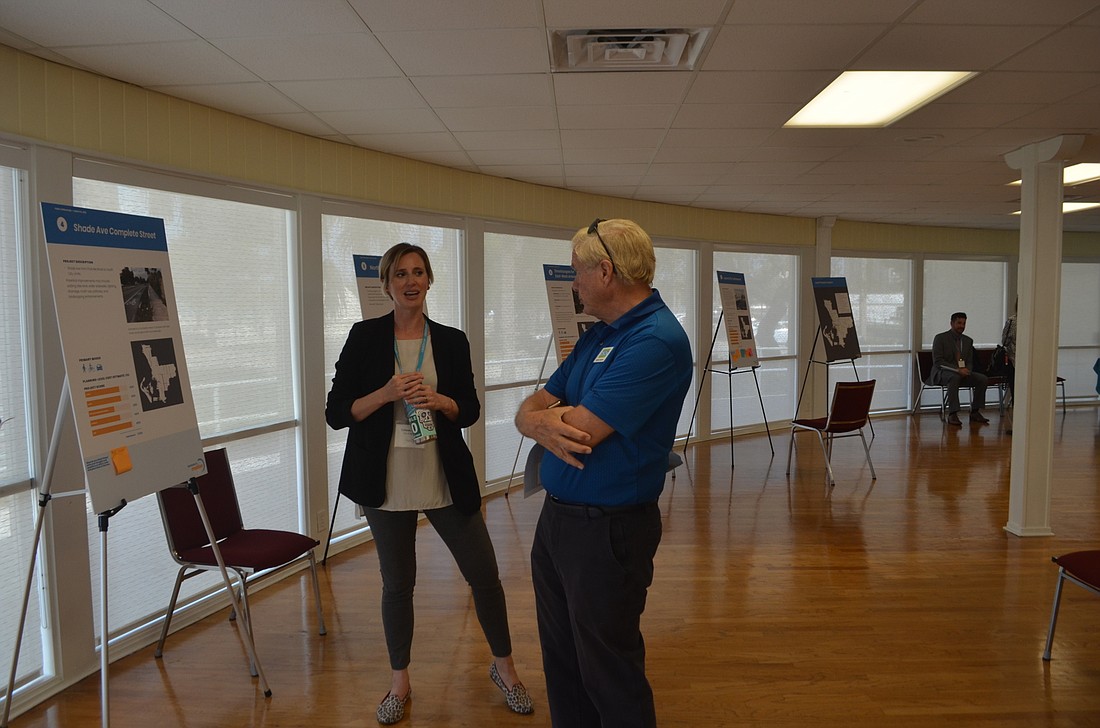- July 26, 2024
-
-
Loading

Loading

Colleen McGue doesn’t just want to change the way people get around the city of Sarasota. She wants to change the way people think about transportation.
McGue, the city’s chief transportation planner, is leading the city’s transportation master planning initiative, called Sarasota in Motion. On Tuesday, the Sarasota in Motion team held a pair of public workshops to share an update, including a list of the top potential projects staff has identified based on community input thus far.
Those projects largely eschew a focus on personal automobile travel, instead striving to create an environment in which people are more comfortable walking, cycling or using public transit. McGue acknowledged this represents a shift from historic priorities in the region, but she said it’s a shift that reflects what residents have told city staff. Survey results indicated that safer intersections and more comfortable bikeway and walkway networks were among the top public priorities.
Although McGue is confident the city’s preliminary plans are reflective of community interest, not everyone is supportive of the goals. Some at Tuesday’s workshop expressed skepticism about actually getting people to use alternate modes of transportation.
“I worry about whether Sarasota weather in the warm months is conducive to getting people moving around town,” resident Kyle Kerbawy said.
One attendee, Dan Lobeck, accused planning staff of being actively hostile to personal automobile transportation and said car-related projects should be a higher priority. McGue and others involved in Sarasota in Motion rejected that claim, stating there were a number of reasons why alternate modes of transportation ranked highly.
That includes the cost associated with expanding roadways and a belief road-widening generally fails as a long-term solution. Planners also noted that pedestrian and bicycle projects can result in benefits for motorists in the form of improved safety or fewer cars on the road. Most importantly, McGue said, members of the public have said they want to be able to bike and walk around town, and they don’t believe the transportation network is designed for that.
“We’re not trying to make life more difficult for people who don’t want to get out of their cars,” McGue said. “We’re trying to give people the option because we’ve heard from people they want that option to get out of the cars.”
Tuesday’s presentations highlighted another statistic planners see as important. A 2019 report from Smart Growth America identified the Sarasota region as the fourth most dangerous metropolitan area in the country for pedestrians. As staff works to finalize a master plan for presentation to the City Commission this summer, McGue said she hoped to see the city prioritize transportation projects not based just on the projected vehicular capacity but also on what would help make the community as a whole a safer place.
“That’s really the theme of this plan: balancing some of those modes of transportation, so we can give people safe options,” McGue said.
Here’s a look at some of the potential projects that landed in the top 10 of the city’s ranking system:
The project ranked No. 1 thus far is the expansion of biking and walking trails.
City staff’s ambition goes beyond the planned extension of the Legacy Trail to Payne Park. It even goes beyond an additional proposed extension of the Legacy Trail from Payne Park to north Sarasota, separately identified as the No. 3 project at Tuesday’s workshop. The scope of the trail initiative could include widening sidewalks, building protected bike lanes, connecting existing trails to the bayfront and connecting neighborhoods to the Legacy Trail.
McGue said the feedback the city has gathered has consistently shown community interest in a more robust trail network.
“We really heard from people that’s the kind of bike facility they want to see, something that’s protected,” McGue said. “We probably will be expanding that project list.”
The city picked three east-west streets it wants to redesign to improve the travel experience for all modes of transportation: 10th Street from the bayfront to Orange Avenue, 12th Street from Orange Avenue to Tuttle Avenue and 17th Street from Orange Avenue to the city limits.
Potential improvements on these roads include wider sidewalks, bike lanes, trails, roundabouts, street furniture and upgraded landscaping.
Three of the top 10 projects focus on the construction of a “complete street” on stretches of road to promote a variety of transportation options.
A complete street is one that allows for multiple travel modes — driving, biking and walking, for example. Potential features include bike lanes, wider sidewalks and upgraded landscaping.
The roads identified for complete street projects are Shade Avenue from Fruitville Road to the city limits, Fruitville Road from U.S. 41 to U.S. 301 and Boulevard of the Arts from the bayfront to Orange Avenue.
The city sees an opportunity to improve its public transportation options to make it a more attractive form of travel, and it wants to focus its energy on destinations where it knows people want to go.
The No. 5 project in the city’s ranking is emphasizing public transit along key routes in hopes of connecting downtown, St. Armands Circle, Sarasota Memorial Hospital and Sarasota/Bradenton International Airport.
An emphasis on public transit could also result in some road redesigns. The No. 9 project focuses on changes to the John Ringling Causeway and Coon Key Bridge that potentially includes the addition of a dedicated lane for transit vehicles and cyclists.
Based on the input workshop attendees left on sticky notes, one of the more controversial projects was ranked No. 8: changing the design of Main Street between U.S. 41 and U.S. 301.
The proposed changes include replacing angled parking with parallel parking, widening sidewalks and potentially turning to the street into a pedestrian-only thoroughfare during certain times at certain locations.
McGue said the reason this project ranked so highly is because Main Street has a high rate of vehicular accidents — usually not serious ones, but often collisions associated with people backing out of parking spaces.